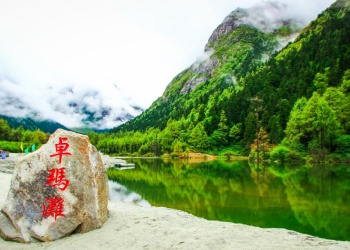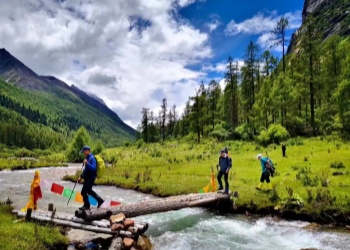Bipeng Valley, located in the Aba Tibetan and Qiang Autonomous Prefecture of Sichuan Province, China, is renowned as the Last Shangri-La of China'. Its landscape features majestic mountains, babbling streams, and a juxtaposition of glaciers with pristine forests, making it a treasure trove of natural ecology. Bipeng Valley not only attracts numerous visitors with its unique geological scenery but also with its rich biodiversity and distinctive Tibetan culture. Visitors can leisurely stroll through verdant forests, listen to the murmurs of streams, and experience the tranquility of alpine meadows. Whether admiring panoramic views from high altitudes or exploring along the way, Bipeng Valley captivates travelers with its mystical and breathtaking allure.
Main Attractions in Bipeng Valley
Longwang Lake
Longwang Lake, located within Bipeng Valley in the Aba Tibetan and Qiang Autonomous Prefecture of Sichuan Province, China, stands as one of the most renowned attractions in the valley. This lake is celebrated for its crystal-clear azure waters and spectacular surroundings of towering peaks. Longwang Lake not only boasts naturally formed glacial lakes and pristine forests but also attracts visitors for its rich biodiversity and unique alpine ecosystem. Visitors can leisurely stroll along the lakeside trail, experiencing the serene atmosphere and fresh mountain air, while enjoying diverse scenery throughout the seasons. It is a paradise for photographers and a must-visit destination for hikers and nature enthusiasts, offering boundless charm and tranquility amidst nature's splendor.


Panyang Lake
Panyang Lake, situated at an altitude of 3,676 meters within Bipeng Valley in the Aba Tibetan and Qiang Autonomous Prefecture of Sichuan Province, China, is another marvel of natural beauty. Named for the presence of wild goats ('panyang' in Tibetan), the lake is renowned for its crystal-clear, transparent waters and stunning surroundings of towering peaks. Formed by glacial meltwater, Panyang Lake remains calm and mirror-like throughout the year, reflecting the surrounding high mountains and pristine forests, creating picturesque and captivating scenery. Beyond serving as a natural canvas, Panyang Lake epitomizes a unique alpine lake ecosystem. The surrounding area supports rich alpine vegetation and rare wildlife such as alpine rhododendrons and mountain goats, making it an ideal site for biological research and nature photography. Visitors can choose to hike or take a sightseeing vehicle to reach Panyang Lake, enjoying the serene waters and majestic mountains along the way. The lakeside features multiple viewpoints and resting areas where visitors can unwind, experiencing the tranquility and mystery of nature.


Zhuoma Lake and Zhuoma Waterfall
Zhuoma Lake and Zhuoma Waterfall are two prominent natural attractions in the region, each possessing unique allure. Zhuoma Lake is a high-altitude mountain lake renowned for its crystal-clear, transparent waters that remain calm and mirror-like throughout the year, reflecting the surrounding high mountains and pristine forests. Fed primarily by glacial meltwater, the lake maintains its clarity and transparency. The area surrounding the lake is rich with alpine vegetation such as alpine rhododendrons and coniferous forests, adding a layer of mystery and romance to the atmosphere.
Zhuoma Waterfall, a highlight of Zhuoma Lake, cascades from high cliffs at the lake's outlet, forming a spectacular waterfall landscape. Especially during summer, increased glacial meltwater enhances the waterfall's flow, producing thunderous sounds and enhancing the grandeur of the scenery. Visitors can choose to hike or take a sightseeing vehicle to reach the Zhuoma Lake and Zhuoma Waterfall scenic area, enjoying the tranquility of the lake and the grandeur of the waterfall along the way. The scenic area features multiple viewing platforms and trails where visitors can relax, experiencing the mystery and beauty of nature.


Best Time to Visit the Bipeng Valley
The best seasons to visit Bipenggou are typically spring and autumn, specifically from April to May and September to October. During these periods, Bipenggou enjoys mild weather with stable conditions, ideal for outdoor activities and scenic photography. April to May in spring is perfect for viewing lakes thawing and mountain flowers in bloom, while September to October in autumn is optimal for enjoying red leaves and autumn scenery. Avoiding the summer rainy season and peak tourist crowds, these seasons also offer a better opportunity to appreciate the tranquility and natural beauty of Bipenggou.
Two Different Tour Route
To get to the scenic area, you can choose between two ways to travel - by sightseeing bus or by electric car.
The sightseeing bus (approximately 20 minutes) will make a stop at the Longwang Sea scenic spot for a visit (recommended time about 20 minutes). You can walk along the lakeside boardwalk to Nam Lake, then continue by bus to the Shanghaizi service station. The total duration of the bus tour is approximately 50 minutes.
The electric shuttle has two segments, with tickets for round-trip travel priced at 30 yuan if both segments are purchased together; individually, each segment costs 20 yuan. Each segment covers approximately 4.5 kilometers. The first segment of the electric shuttle runs from Shanghaizi Station to Panyang Lake, taking about 10 minutes. After disembarking at Panyang Lake, you can follow the cement road on the right towards Moon Bay, then transfer to the second segment of the electric shuttle to Yanziyanwo. The second segment lasts approximately 10 minutes, and upon disembarking, you can hike around the scenic mountain and water area. Return to the disembarking point to board the electric shuttle for the return journey.


Travel Tips
Plan for Altitude: Bipenggou is at a high altitude, so acclimatize slowly to prevent altitude sickness.
Dress in Layers: Weather can change quickly, so bring layers for warmth and protection from rain or wind. (temperature can drop drastically from 27 degrees Celsius at 3 PM to a sharp decrease of over 10 degrees Celsius at 6 PM)
Comfortable Footwear: Wear sturdy shoes suitable for walking on uneven terrain.
Bring Snacks and Water: Have snacks and enough water for hikes and walks, as facilities may be limited on trails.
Sun Protection: Use sunscreen, a hat, and sunglasses, especially if spending time outdoors.
Check Operating Hours: Verify the operating hours of attractions and services like shuttles or visitor centers.
Essential Items to Bring: Sun hat (essential due to intense UV rays); Motion sickness medicine (highlighted as necessary! The bus is on a mountain road with continuous hairpin turns); Oxygen cylinder; Snacks; Power bank.
Travel Information
Ticket Prices and Scenic Area Transportation:
Combined ticket with bus: 130 RMB/person
Individual ticket for non-group visitors: 70 RMB/person
Sightseeing bus ticket: 60 RMB/person (mandatory)
Sightseeing electric shuttle (two segments, voluntary):
First segment from Shanghaizi to Panyang Lake, approximately 4.5 km (round trip 30 RMB/person, one-way 20 RMB/person)
Second segment from Moon Bay to Swallow Rock, approximately 5 km (round trip 30 RMB/person, one-way 20 RMB/person)
Scenic Area Operating Hours:
Summer: 08:00 - 17:00
Winter: 08:30 - 17:00 (Ticket sales end at 15:00, last entry at 15:00)

































